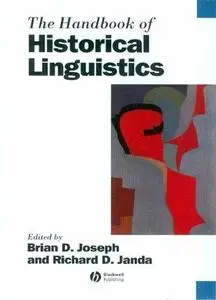The Handbook of Historical Linguistics By
2002 | 895 Pages | ISBN: 0631195718 | PDF | 5 MB
2002 | 895 Pages | ISBN: 0631195718 | PDF | 5 MB
The Handbook of Historical Linguistics provides a detailed account of the numerous issues, methods, and results that characterize current work in historical linguistics, the area of linguistics concerned with language change as well as past language states.Provides a comprehensive and current account of the numerous issues, methods, and results that characterize historical linguistics. Contains an extensive introduction that places the study of historical linguistics in its proper context within linguistics and the historical sciences in general. Covers the methodology of historical linguistics and presents sophisticated overviews of the principles governing phonological, morphological, syntactic, and semantic change. Includes contributions from the leading specialists in the field.Content: Chapter 1 Introduction Contents (pages 1–2): Chapter 1 The Comparative Method (pages 199–212): Robert L. RankinChapter 2 On the Limits of the Comparative Method (pages 213–243): S. P. HarrisonChapter 3 Internal Reconstruction (pages 243–261): Don RingeChapter 4 How to Show Languages are Related: Methods for Distant Genetic Relationship (pages 262–282): Lyle CampbellChapter 5 Diversity and Stability in Language (pages 283–310): Johanna NicholsChapter 6 The Phonological Basis of Sound Change (pages 311–342): Paul KiparskyChapter 7 Neogrammarian Sound Change (pages 343–368): Mark HaleChapter 8 Variationist Approaches to Phonological Change (pages 369–400): Gregory R. GuyChapter 9 “Phonologization” as the Start of Dephoneticization — Or, On Sound Change and its Aftermath: Of Extension, Generalization, Lexicalization, and Morphologization (pages 401–422): Richard D. JandaChapter 10 Analogy: The Warp and Woof of Cognition (pages 423–440): Raimo AnttilaChapter 11 Analogical Change (pages 441–460): Hans Henrich HockChapter 12 Naturalness and Morphological Change (pages 461–471): Wolfgang U. DresslerChapter 13 Morphologization from Syntax (pages 472–492): Brian D. JosephChapter 14 Grammatical Approaches to Syntactic Change (pages 493–508): David LightfootChapter 15 Variationist Approaches to Syntactic Change (pages 509–528): Susan PintzukChapter 16 Cross?Linguistic Perspectives on Syntactic Change (pages 529–551): Alice C. HarrisChapter 17 Functional Perspectives on Syntactic Change (pages 552–572): Marianne MithunChapter 18 Grammaticalization (pages 573–601): Bernd HeineChapter 19 Mechanisms of Change in Grammaticization: The Role of Frequency (pages 602–623): Joan BybeeChapter 20 Constructions in Grammaticalization (pages 624–647): Elizabeth Closs TraugottChapter 21 An Approach to Semantic Change (pages 648–666): Benjamin W. FortsonChapter 22 Phonetics and Historical Phonology (pages 667–686): John J. OhalaChapter 23 Contact as a Source of Language Change (pages 687–712): Sarah Grey ThomasonChapter 24 Dialectology and Linguistic Diffusion (pages 713–735): Walt Wolfram and Natalie Schilling?EstesChapter 25 Psycholinguistic Perspectives on Language Change (pages 736–743): Jean Aitchison



